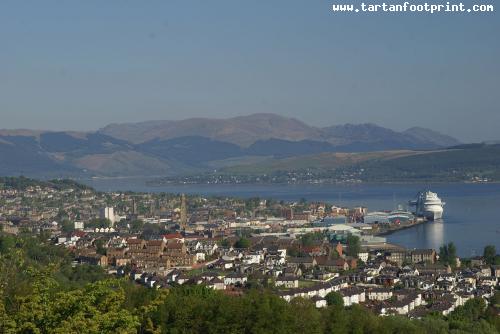You seem to be using an older version of Internet Explorer. This site requires Internet Explorer 8 or higher. Update your browser here today to fully enjoy all the marvels of this site.
December 7, 2018 by Alexander Meldrum
Scotlands Citys & Towns
Greenock
Greenock Scottish Gaelic: Grianaig, pronounced [ˈkɾʲiənɛkʲ]) is a town and administrative centre in the Inverclyde council area in Scotland and a former burgh wi...Scotlands Citys & Towns
Greenock
Greenock Scottish Gaelic: Grianaig, pronounced [ˈkɾʲiənɛkʲ]) is a town and administrative centre in the Inverclyde council area in Scotland and a former burgh within the historic county of Renfrewshire. located in the west central Lowlands of Scotland. It forms part of a contiguous urban area with Gourock to the west and Port Glasgow to the east.
It lies on the south bank of the Clyde at the "Tail of the Bank" where the River Clyde expands into the Firth of Clyde.
History
The origin of the name is unknown; Smith (1921) suggested that the Common Brittonic Graenag, a "gravelly" or "sandy place" accurately describes the foreshore before the docks and piers were constructed, while the Gaelic options of Grianach ("sunny bay") or grian cnoc ("sunny hill") were seen by locals as less credible. Johnston (1934) notes that "some Gaels call the seaport Ghónait", and that a possible derivation may be greannach, meaning "rough, gravelly".
The option of grian aig, from Gaelic words for "sunny place" or "bay", has been taken up by the local authority as the Gaelic translation of the name. The name of the town has had various spellings over time. It was printed in early Acts of Parliament as Grinok, Greenhok, Grinock, Greenhoke, Greinnock, and later as Greinok.
Old Presbyterial records used Grenok, a common spelling until it was changed to Greenock around 1700.
The spelling Greenoak was found in two factory accounts dating back to 1717, and a legend developed of a green oak tree at the edge of the Clyde at William Street being used by fishermen to tie up their boats. This has been generally dismissed as imaginative folk etymology, but the image has frequently been used as an emblem or logo, carved on public buildings, used on banners and badges, and was once emblazoned on the local Co-operative Society emblem.
The town's modern indoor shopping centre is called The Oak Mall and uses a green tree as its logo. The name is also recalled in a local song (The Green Oak Tree).
Significantly, no green oak appears on the town's coat of arms which features the three chalices of the Shaw Stewarts, a sailing ship in full sail and two herring above the motto God Speed Greenock. Anecdotal evidence suggests that there was a 'Green Oak Tree', situated in Cathcart Square, at the top end of William Street, close to the Oak Mall – indeed, a horseshoe set into the cobblestones, between the 'Mid-Kirk' church and the central feature of the square, was where it once, supposedly, grew.
Early history: baronies and kirks
The Old West Kirk of 1591, much altered over the years, was moved in 1928 to a new location, again close to the Firth of Clyde. Hugh de Greenock was created a Scottish Baron in 1296, and the seat of the feudal barony of Greenock was apparently what became Easter Greenock Castle.
Around 1400 his successor Malcolm Galbraith died with no sons, and his estate was divided between his two daughters to become two baronies: the eldest inherited Easter Greenock and married a Crawfurd, while Wester Greenock went to the younger daughter who married Schaw of Sauchie. Around 1540 the adjoining barony of Finnart was passed to the Schaw family, extending their holdings westward to the boundary of Gourock, and in 1542 Sir John Schaw founded Wester Greenock castle. The Scottish Reformation of 1560 closed the chapels in the parish, and as the parish church was some 6 miles (9.7 km) distant at Inverkip over a difficult route which was impassable in winter, in 1589 John Schaw obtained a charter from King James VI to build a kirk for the "poor people upon his lands who were all fishers and of a reasonable number". Later known as the Old Kirk or the Old West Kirk,
it was constructed on the west bank of the West Burn estuary and is reputed to have been the first Protestant church built in Scotland after the Reformation.
Go to Wikipedia for full History
In this photo:


